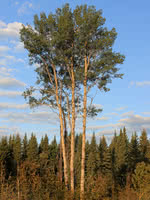Mon-Fri 9am - 5pm Mountain time
Trembling Aspen vs Common Hackberry
Populus tremuloides
Celtis occidentalis
Trembling Aspen is a hardy, fast-growing tree. It is known for its unique "trembling" leaf movement and beautiful bark that whitens with age.
This native shade tree tolerates a range of growing conditions and requires little maintenance.
The Common Hackberry is a medium-sized deciduous tree that resembles the American Elm but is immune to Dutch Elm Disease. They are versatile and can adapt to a variety of growing conditions.
It produces purple-red, berry-like fruit with a large seed in the center. Both the sweet flesh, which tastes similar to dates, and the crunchy seed are edible. The fruit remains on the tree throughout the winter, offering a valuable food source for birds and other wildlife.
The Common Hackberry can also be a great addition to a pollinator garden. The tree itself is a host for the larvae of several butterfly species and the flowers provide a source of pollen and nectar.

